We are entering conference season, with a number of upcoming events celebrating and discussing Mormon literature and art. Most of these will be available at least partially online.
AML will hold a book club on March 27, and its own conference in July.
The Mormon Scholars in the Humanities holds its conference, with the theme “Aesthetics”, March 24-26.
The Mormon Historical Association holds its conference, “Landscape, Art, and Religion: The Intermountain West and the World” on June 2-5.
The Center for Latter-day Saint Art is holding several interesting events at its Center Gallery in New York City.
Also, recent and upcoming books and podcasts.
The AML Book Club will be discussing the newest issue of Irreantum, Wine into Water: Contemporary LDS Poems about Christ, March 27, 7pm Mountain time.
The issue’s editor, Kevin Klein, will be joining us to speak about the process behind the issue. Several of the featured poets will speak for a few minutes each about their poems and their reaction to the project: Lance Larsen, Carol Lynn Pearson, Darlene L. Young, Bruce Jorgensen, and Gabriel Gonzalez Nuñez. In addition, poets Javen Tanner, Alixa Bobbrey, Gregory Brooks, and Daniel Cooper will also attend, and can answer any questions about their poems.
Join us for a fascinating discussion of LDS poetry!
https://us02web.zoom.us/j/87507107246?pwd=V0praVJiWE9jU1dyOWJNcHNZa2xrdz09
Meeting ID: 875 0710 7246
Passcode: 488895
The AML Book Club is a monthly online discussion group, to which all are invited, free of charge.
Association for Mormon Letters Annual Conference
Mormon Literature Progress & Prospects: The Legacy of Eugene England, July 21-23, 2022
The submissions deadline is April 30, 2022.
Mormon Scholars in the Humanities Annual Meeting
 Pembroke College, University of Oxford
Pembroke College, University of Oxford
March 24–26, 2022 “Aesthetics”
Register for the full virtual conference on Luma here
Among the literature and art related presentations are:
Thursday, March 24
Bright Spark: The Reconciliation of Trevor Southey
2022 film, by Nathan Florence and Matt Black
Friday, March 25
Based on a true story”: fiction, nonfiction, and truth narratives, 1971–2011
Beginning in 1971 with Church-wide correlation, Church magazines consolidated around three core magazines: The Ensign for adults, The New Era for youth, and The Friend for children. Faith-promoting narratives—both fiction and non-fiction—provided the bulk of the magazines’ material and shared space for the first twenty years of these publications. However, beginning in the 1990s, the magazines quietly shifted away from fiction stories to nonfiction stories. This paper analyzes the shift away from fiction stories, particularly in The Friend, and analyzes the aesthetic, practical, and theological implications of this shift.
Megan Armknecht, Princeton University
The mission theology of EFY music, 2000–2015
Although the mission program and missionaries of the Church of Jesus Christ of Latter-day Saints are iconic, there is virtually no formal Latter-day Saint mission theology. Nevertheless, informal attempts at characterizing Latter-day Saint mission abound in media portrayals—especially in media aimed at youth. This paper examines the theological implications of mission-related music from “Especially for Youth” albums in order to sense popular understandings of Latter-day Saint mission and some of the potential (un/intended) effects of those approaches to missionary work.
Greer Cordner, Boston University
Transcending form and speaking to eternal truths: poetry for youth in the New Era
Since the first edition of the freshly minted New Era, poems have been regularly published in this magazine. The topics of these published poems have varied from purely aesthetic depictions of nature, to musings about love, to proclamations of core doctrines of the church. Many verses do not discuss the gospel or openly mention God or faith. Such a diversity of poetry within officially sanctioned Church magazines illustrates that not all literature must be overtly didactic to be considered inspirational and faith-building.
Sharisa Aidukaitis, University of Virginia
Mormon kitsch: a Deweyan critique of aesthetics in Mormon worship and culture
John Dewey conceptualizes aesthetic experience as a moment of meaningful and transformative fulfillment of the human creature within its ever-shifting environment. Aesthetic experience helps a person find adaptation through struggle, as well as harmony and enjoyment in the world. These qualities can be highly desirable in cultivating a nourishing religious life and culture, and art is vital to the perpetuation of aesthetic experience. Dewey’s aesthetics also assert that robust dialectic discourse is a necessary quality in the creation and engagement of true art. Constricted communication within a culture produces an aesthetic anemia that coincides with the use and production of propaganda, or kitsch artifacts. Using Robert Lifton’s concept of the thought reform device, I examine the cognitive and linguistic mechanisms that lead to constricted discourse. I offer evidence for the existence of such devices in Mormon culture and worship and begin to examine their detrimental impact on Mormon aesthetics. To move toward the development of a healthy aesthetic ecosystem within the church, members can remove blocks to such discourse by developing awareness of these phenomenon within their own psyche, so as to free themselves to engage fully in critical thought and conversation.
Faith Heard, Independent Scholar
Art in the time that remains
As former producer of Brigham Young University’s annual theatre season, I have observed that many patrons’ discourse of theatre has abandoned a nuanced understanding of art, in exchange for an aesthetic framework of “entertainment.” Perhaps this should not be surprising, since the For the Strength of Youth pamphlet—published by the same religious organization that sponsors BYU—is also absent any discussion of art, referring only to “entertainment” and “media.” Inspired by this set of observations, my presentation will begin to re-think “art” outside its typical traditions and attempt to relocate it in its proper place—if there is such a place—in the Kingdom of God. In my re-thinking I will triangulate between “the time that remains” (Giorgio Agamben), “the distribution of the sensible” (Jacques Rancière), and “non-conceptual objects” (Theodore Adorno).
Wade Hollingshaus, Brigham Young University
Fantastic Beasts and Where to Find them in Mormon Literature
In recent decades, several LDS authors have emerged as leaders in the fields of science fiction and fantasy genres. Terryl Givens situates some of the more radical doctrines of Mormonism in this liminal space and sees connections between LDS theology and such sci-fi/fantasy tropes as apotheosis and alien intelligences. Scott Parkin notes that the harmonious coexistence of science and theology within Mormonism also equips LDS authors to grapple with concepts outside the familiar, the known, or the verifiable. My paper addresses the gap between these two positions: focusing on the depiction of fantastic beasts in LDS speculative fiction, I will consider the aesthetics of these depictions, their relation to Mormon cultural norms, and the role of speculative fiction more generally within the LDS Church.
Julie K. Allen, Brigham Young University
Aisthesis is feeling, say voices from the dust
Tolstoy says that art “transmits feelings” from makers to recipients, and my experiences with sculpture, painting, music, film, and especially poetry, fiction, and scripture will not let me gainsay that. Together with other witnesses, he pulls me toward Susan Sontag’s suggestion that “In place of a hermeneutics we need an erotics of art.” So I wonder: who has better reasons to explore that than we whose scriptures declare that “the spirit and the body are the soul of man” and that “spirit and element inseparably connected receive a fulness of joy”?
Bruce Jorgensen, Brigham Young University (ret.) (Virtual)
Possibilities and problems in integrating aesthetic evolution into an LDS framework
I attempt to illuminate two interrelated areas of Mormon philosophy through the frame of sexual evolution. First, Mormon discourse on evolution, in spite of excellent recent work of Steven Peck and others, has focused far more on traditional Protestant concerns like the special (or not) creation of “man,” to the exclusion of addressing the challenge of aesthetic mate choice for a natural-theological framework. Does Beauty occur in nature as an attribute of a Creator, or as the manifestation of “base” impulses of his creatures, or (my view) both? Second, I explore how specific findings of sexual evolutionists both demand that Latter-day Saints reconcile their discourse on chastity to the erotic undercurrent of everyday life—particularly in its relation to the aesthetic sense—and suggest a path toward doing so.
Ian McLaughlin, Independent Scholar
Archiving Mormonism
For the last decade, the L. Tom Perry Special Collections in the BYU Library has emphasized collecting and documenting Mormonism in the 21st century. The panel I am proposing will discuss the archives materials related to the humanities, share insights on our current collecting trends, and highlight available resources to scholars such as the BYU Web Archive.
Trevor Alvord and Dainan Skeem, Brigham Young University
Saturday, March 26
Possibility and potential: a Mormon aesthetics of the charismatic
This paper will introduce the history of Mormon charismatic practices, focused around the trajectory of glossolalia within Mormonism, and will develop a reading of several contemporary examples of an explicit charismatic aesthetic as found in contemporary Mormon literature (Renee Angle’s experimental poetic re-imagining of the lost 116 pages, entitled WoO [2016], and Marita Dachsel’s series of poetic monologues voiced by Joseph Smith’s plural wives, entitled Glossolalia [2013]), arguing that a charismatic aesthetics is an aesthetic acceptance and reworking of a Spirit experience within the fundamental framework of Mormon materiality. A Mormon charismatic aesthetics thus enacts a mode of thinking otherwise: a simultaneously material and Spirit mode that presents an alternative strategy, a divergent perspective, an otherwise form for thought/thinking. In developing these contours, the paper explores the theological emphasis within Mormonism on potential, possibility, and multiplicity in ways that then reflect back on the Mormon aesthetic project as a whole as gathering up and together rather than divisionary demarcation.
Jenny Webb, Independent Scholar
An aesthetics of memory: Derrida and Latter-Day Saint archive fever
Many Latter-day Saint thinkers have proposed various aesthetics for our literary tradition. Zion, embodied deity, missionary service, and other aesthetic concepts have enriched our understanding of Latter-day Saint experience. In this paper I build on this foundation and suggest that stemming from the very beginnings of Mormonism is another aesthetic, an aesthetic of memory. I’ll borrow from Derrida’s three concepts of memory to discuss how records and memory have influenced Latter-day Saint theology and literature.
Gerrit van Dyk, Brigham Young University
Decolonizing “Mormonism”: toward a universal Latter-day Saint literary theory
This paper proposes a theory that decolonizes what it means to be a Latter-day Saint by removing any cultural or geographical markers that would situate Latter-day Saint identity—and subsequent literary criticism— in a specific, provincial habitus. This paper proposes a rejection of the “Mormo-American” approach to literature and criticism in favor of a more universal and accessible literary theory that contains a truly global vision of what it means to be a Latter-day Saint.
Peter Eubanks, James Madison University
Towards a Mormon iconography: LDS women’s writings on art and aesthetics, 1900–1950
In the early twentieth century, a number of LDS women became ardent aesthetic evangelists. Capitalizing on the broader trends of the sacralization of art and women as cultural custodians, Emmeline B. Wells, Leah Widtsoe, Alice Merrill Horne, Mary Teasdel, Mabel Frazer and others wrote extensively about the potential power of art for spreading the Gospel of Jesus Christ. Church-sponsored publications such as the Relief Society Magazine and the Young Woman’s Journal were filled with an abundance of art-related material, including philosophical exegeses, educational materials, exhibition reviews, and reproductions of artworks. This paper will present the general contours of early twentieth-century women’s writings on their vision for the development of the faith’s art, and will argue for the centrality of these women to the formation of a Mormon aesthetics and iconography.
Heather Belnap, Brigham Young University
A brief history of heavenly mother in Latter-day Saint poetry and art
I will share a brief aesthetic history of Mother in Heaven in poetry and art, focusing especially on the flourishing and expansive direction of both over the last ten years.
Rachel Hunt Steenblik, Wenzhou Kean University (Virtual)
The Brain’s Lectionary: God, literature, and the wounded brain
What does a believer do when an important organ of belief, the brain, is undone and God falls through the cracks of shattered neurons and electrical signals mislaid? when memory, cognition, and language (important means for communicating with God) are wounded? A person’s neurology aids in the human experience of the divine, and a wounded brain can wound that connection. In the process of healing such a wound, study, belief, and art-making are not merely academic endeavors. They are neurological enterprises that shape the body in new directions. Even if the believer has a hard time beholding God in the midst of a soul-crushing disconnect between heaven and earth, body and spirit, the self still beholds itself in the process of becoming, healing, reaching. That self-directed act of beholding a wounded vessel in the process of coming to God is a holy and sacred ground. By exploring my process of creating The Brain’s Lectionary: Psalms and Observations, a book of poems and linocut illustrations I made in the wake of a traumatic brain injury, I will talk about this experience of remaking the self, allowing myself to behold (both myself and God), and becoming (a believer in the process of being neurologically reborn).
Elizabeth Pinborough, Independent Scholar
Mormon History Association 57th Annual Conference
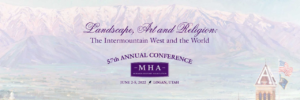 Landscape, Art, and Religion: The Intermountain West and the World. June 2-5, Logan, Utah
Landscape, Art, and Religion: The Intermountain West and the World. June 2-5, Logan, Utah
Among the literature and art related presentations in the preliminary program are:
June 3
The development of Latter-day Saint Iconography
Indigenous Women Speak: Navajo Canyonlands meet the NY Gorges: A Poetry Reading (Tacey M. Atsitty)
“Lousie Erdich’s Mormon History in The Night Watchman” (P. Jane Hafen)
Landscapes of the Soul in Women’s Literature
“No Gospel Could Ever Mean So Much to a Woman: Ambivalent Sexism in The Giant Joshua” (Tara Godwin)
“Landscapes, Reality, and Metaphor in the Works of Maurine Whipple (Lynne Larson)
“‘The Almost Unknown West’: Landscapes in the Writings of Danish Latter-day Saint Women in Utah” (Michelle Graabek)
Sounding the Depths
Alex Caldeiro and the Terrestrial Soundscape (Tyler Chadwick)
Confronting Colonialism Through Magic: Brandon Sanderson’s Stormlight Archive in Conversation with Mormon Colonialism (Liz Busby)
Lands of Promise (Mormon Lit Blitz)
James Goldberg, Nicole Wilkes Goldberg, Katherine Crowley
Book of Mormon Landscapes
“The Poetic Landscape of the Book of Mormon and its Literary Inerpreters” (Gerrit VanDyk)
“Imagining a Book of Mormon Landscape: Changing ideas of geography and climate in fiction about the Book of Mormon (Kent Larsen)
Building Zion in Latin America
“Writing Zion: The Literary Landscape for 20th-century Spanish Speaking LDS Poets” (Gabriel Gonzalez Nunez)
Landscape in Contemporary Fiction
Todd Robert Peterson and Rosalyn Eves
Saturday, June 4
Gay Mormon Literature Project
“Faithfully Living, Fictionally Portraying the Struggle for Latter-day Saint Gay Idenitity in Literature” (Adam McLain)
“Nine Years Later: Brining Members of the Church of Jesus Christ of Latter-day Saints Up to Date with Gay Mormon Literature (Gerald Argetsinger)
“Historical Characters, Contemporary Plays: Queer Futures Performing the Past as Advocacy for LGBTQ+ Inclusion (Kristin Perkins)
Suburban Landscapes in Contemporary Mormon Literature
“The Grace of the Mundane: Making Art from Suburbia” (Darlene Young)
“The Extraordinary Landscapes of Contemporary Mormon Fiction” (Angela Hallstrom)
“The Suburbs and Other liminal Spaces” (Lisa VanOrman Hadley)
Landscape as Lens, LDS Poets Writing the Sacred
Elisa Eastwood Pulido, Lance Larsen, Susan Elizabeth Howe, Dave Nielsen
Literature of Transition
“Susa Young Gates’ Embrace and Critique of the Couple-Centered Home in John Stevens’ Courtship” (Natalie Brown)
“‘A Very, Very Sad Disappointment’: Landscape, Gender, and Religious Devotion in Nephi Anderson’s Piney Ridge Cottage” (Scott Hales)
“Where Nothing is Long Ago: The Landscape of Memory in Virginia Sorensen’s Writing” (Sarah Reed)
Center for Latter-day Saint Art
Exhibitions:
 John Held, Jr. (American, 1889-1958)
John Held, Jr. (American, 1889-1958)
March 16 – May 31, 2022 | Center Gallery, NYC
Upon his death at the age of 69, The New York Times observed that John Held, Jr. had been in his heyday, “one of the country’s best known cartoonists.” The obituary continued, “Such was Mr. Held’s reputation, he recalled recently, that people sent him blank checks to make drawings for them.” He epitomized the Jazz Age with his colorful drawings of flappers and their collegiate boyfriends, and his humor was a constant presence in newspapers, advertisements, and on the covers and pages of Vanity Fair, Collier’s, Life, Judge, College Humor, Punch, Mademoiselle, Cosmopolitan, and The New Yorker magazines. His friends F. Scott Fitzgerald, Robert Sherwood, and Eugene O’Neill defined the era, and John Held, Jr. designed it. Held came from a Mormon Utah family. His fine art works of drawings, watercolors, and sculpture have rarely been displayed, with no significant exhibition in recent decades. Few people know Held’s works for theater, movies, ballet, product design, advertising, and his writing: his four collections of short stories and four novels. Curated by Glen Nelson.
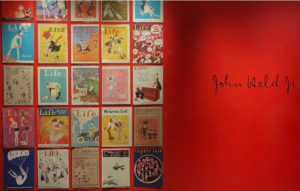 John Held, Jr. Fiction: An Evening of Short Stories
John Held, Jr. Fiction: An Evening of Short Stories
March 25, 2022, 7:00 p.m.
Reading from rare, first edition copies of Held’s four collections of short stories, a duo of Broadway actors give a performance of selected stories (largely unknown) from the Jazz Age. In conjunction with the exhibition, the Center is publishing a new book by Glen Nelson, John Held, Jr.’s Fiction that covers the four novels and four collections of short stories published between 1930-1937.
The Sacred Feminine in LDS Art & Theology
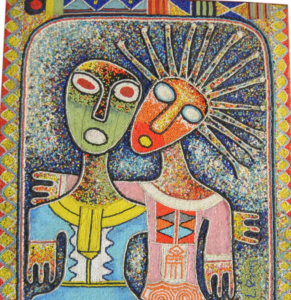 Center Gallery, NYC | January 14- March 6, 2022
Center Gallery, NYC | January 14- March 6, 2022
Organized by Margaret Olsen Hemming
In the last decade, LDS artists have begun exploring ideas about Heavenly Mother’s power and meaning in greater quantity and diversity than ever before, although the earliest known depictions date from the nineteenth century. Some artists have chosen to depict their figurative version of Heavenly Mother, while others have used abstract images to assert her unknowability as a divine being. Yet others have used figures or symbols to share the qualities they believe Heavenly Mother possesses. This exhibit seeks to examine the diverse ways that LDS artists engage with the concept of a feminine presence to which our spirits yearn, yet which is simultaneously more vast and unfathomable than the mortal experience can comprehend.
11th Annual Mormon Lit Blitz Call for Submissions
Submissions for the Eleventh Annual Mormon Lit Blitz writing contest are due on 30 April 2022 to everydaymormonwriter@gmail.com. Submitted works may be in any genre so long as they are under 1,000 words and designed to resonate in some way with a Latter-day Saint audience. Submissions may be written in any language. Previously published material and simultaneous submissions are acceptable. Up to three submissions are allowed per author.
Recent notable books
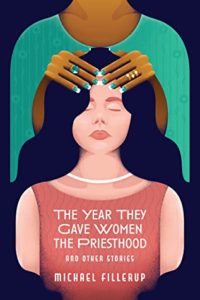 Michael Fillerup. The year they gave women the priesthood and other stories. Signature Books, March.
Michael Fillerup. The year they gave women the priesthood and other stories. Signature Books, March.
In this new collection of short fiction, award-winning author Michael Fillerup explores the shuttered landscapes of Mormon culture where feel-good clichés falter and the faithful are scorched in the refiner’s fire. The seventeen stories in Fillerup’s new compilation run the gamut in length, style, and voice, but all share an unapologetic authenticity. Whether examining the hypocrisy of sexism, the crucible of forgiveness, or the heartbreak of parenthood, Fillerup leads readers through a labyrinth of emotions but never feeds them to the Minotaur. Light shines at the end of each tortuous tunnel and, to the thoughtful reader, genuine joy.
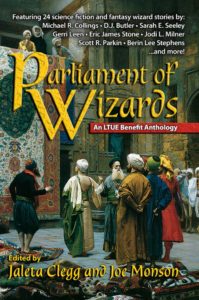 Jaleta Clegg and Joe Monson, editors. A Parliament of Wizards. Hemelein Publications, February.
Jaleta Clegg and Joe Monson, editors. A Parliament of Wizards. Hemelein Publications, February.
An anthology of fantasy and science fiction wizard stories. This volume is created in memory of Jonathan Langford, one of the founders of Life the Universe, & Everything and The Leading Edge. Proceeds from sales of the anthology go to support LTUE in allowing students to attend for a greatly reduced price. It includes stories and poems by twenty-three authors, including D. J. Butler, Eric James Stone, Michael R. Collings, and Scott R. Parkin.
Coming Soon:
Novels:
John Bennion. Spin. BCC Press, Spring
Steven L. Peck. Heike’s Void. BCC Press, Fall
Poetry:
Creative Nonfiction:
Hemelein Publications’ “Legacy of the Corridor” series:
Sharks in an Inland Sea by Lehua Parker (short fiction collection, June)
The Bacillus of Beauty by Harriet Stark (republication of a 1900 science fiction novel, July)
In the Haunting Darkness by Michael R. Collings (collection, October)
Podcasts
Dialogue Out Loud #17: 2021 Winter Poetry
Featuring the poets David K. Isom, Judy Darke Delogu, and Gerrit van Dyk.
Dialogue Out Loud #16: Fear, Faith, and Other F-Words
In this important and beautiful personal essay, T Boyd describes how OCD/anxiety affect their religious life.
Dialogue Book Report #15: Restoration and Proclaim Peace by Patrick Mason
Dialogue Book Report #14: Mormon Book Roundup, January 2021
Dialogue in Review #2: Mormonism and the Arts, Fall 2021
Authors from the Fall 2021 issue discuss and answer questions about their perspectives and experiences in the LDS faith tradition, and their hopes for Mormon scholarship, culture, community, theology, and lived religion. Featuring Blaire Ostler, Gregory Brooks, Ron Richmond, Esther Hi’ilani Candari, and Jeanine Eyre Bee.
The Sacred Feminine: A Panel Discussion
Curator Margaret Olsen Hemming, artist Kwani Povi Winder, and scholar Vinna Chintaram gather to talk about different approaches to and perspectives on Heavenly Mother as they react to the exhibition at the Center Gallery, The Sacred Feminine in LDS Art & Theology.
Margaret Olsen Hemming and Picturing the Sacred Feminine
To mark the exhibition opening, The Sacred Feminine in LDS Art & Theology, at the Center Gallery in New York, its curator Margaret Olsen Hemming speaks about global artworks that imagine what Heavenly Mother is like. The LDS doctrine that we are from heavenly parents is not new, but recent LDS artists from around the world are building on the artistic foundation laid more than 100 years ago by poet Eliza R. Snow and painter John Hafen to further a discussion about the nature and role of the sacred feminine.

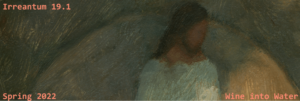
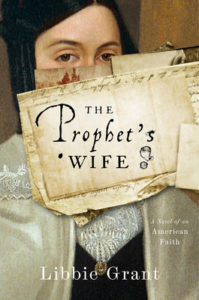
.
Wow.
This is a startlingly excellent list of stuff. Holy smokes!
It’s a startlingly massive list of stuff. Hokey smokes, indeed! 🙂